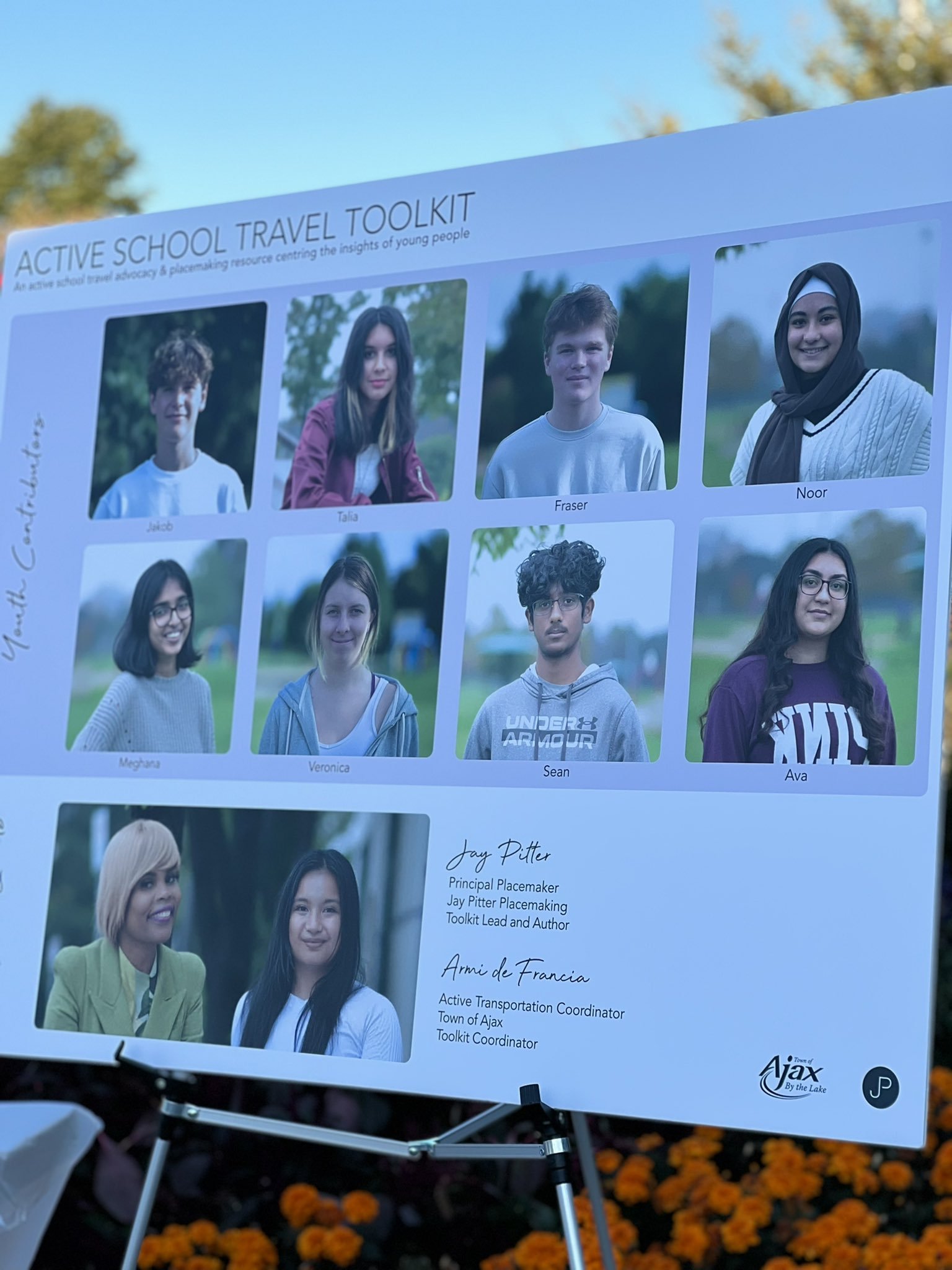The People, Projects, and Places that Inspired us in 2022
Woman sitting in a pedestrian square in Montreal, QC (photo by: Nicole Roach, 2022)
Over the course of 2022, there have been many influential and resourceful advancements in gender and equity in Canadian cities. Whether it be exploring new ways of thinking of the built environment or adding an initiative or idea to our organizational “wish list”, many of these advancements have inspired the work we do here at Women in Urbanism Canada in one way or another.
On the whole, all of the small and big news that has crossed our feeds and has been personally shared with us has played some role in the way we hope to shape Canadian cities in the future. Below is a (short) list of people, projects, and places who made an impact on us in 2022.
People who Inspired us
Ontario Community Changemaker, Tennesha Joseph, uses a participatory and bottom-up approach in planning to center knowledge, dreams, fears, and experiences of marginalized groups. She uses this approach to offer groups who typically lack representation in the urban decision-making process an opportunity to be part of projects, particularly women and girls.
As a result, Tennesha developed Are You Afraid of the Dark T.O?, a temporary outdoor public installation for women and girls, using unique seating arrangements and LED lighting. The project works to gather participatory data and improve perceptions of safety at night to encourage activities after-dark.
Are You Afraid of the Dark T.O? promotional graphic. (Source: 8 80 Cities Instagram Page)
Former Cycling Educator and Communications Manager for Cycle Toronto, Ry Shissler, uses storytelling to share LGBTQ2S+ stories in cycling. Ry focuses on helping guests, listeners, and readers to look beyond stereotypical appearances and experiences of cyclists, highlighting and celebrating the many different identities that exist in cycling.
Ry’s personal experience of being a non-binary person in cycling encouraged them to develop They Cycle Canada, a platform that tells queer-focused stories of people on bikes. The developing initiative works to bring people together who have been othered for being themselves in the cycling world, looking inward instead of focusing on what people see on the outside.
Ry Shissler on a bike with a quote from them (Source: They Cycle Canada Instagram Page)
International Placemaker, Author, and Lecturer, Jay Pitter, works to mitigate the growing divides of marginalized groups in cities across North America. Her equitable planning approach has helped schools, municipalities, and organizations develop and revisit initiatives in public space design, policy, forgotten densities, mobility, gender-responsive design, inclusive public engagement, and healing fraught sites.
Recently, Jay partnered with teens and the Town of Ajax to launch the Active School Travel Toolkit, an active school travel advocacy & placemaking resource centering the insights of young people. The toolkit was developed in close collaboration with young students, making it one of the first active school travel kits created for and by students.
Jay Pitter pictured with students she co-collaborated with on project poster (Source: Jay Pitter’s Twitter Account)
Projects we Loved
Toronto-based not-for-profit organization, BIKEPOC, is a social cycling group for Black, Indigenous, and People of Colour (BIPOC) who identify as women, trans, and non-binary and enjoy riding their bike and connecting with others.
Their mission is to build a safe space for this intersectional community, while bringing more exposure to the multiple identities that partake in biking that typically lack representation. The group aims to help shift this narrative through rides, workshops, and a bike match program.
Group of riders from BIKEPOC posing for a photo (Source: BIKEPOC Instagram Page)
Depave Paradise, an initiative funded and coordinated by Green Communities Canada, removes asphalt in neglected urban spaces and turns them into living green spaces with the help of community members and dedicated volunteers.
In 2022, a total of 15 new Depave projects were completed across the country, helping to convert a total of 16,384 m2 of unused paved surfaces since the project began in 2012, into green spaces that foster community and grow native grasses, flowers, and trees. Depave Paradise is a growing part of the Our Living Cities Canada program, which aims to advance green infrastructure (GI) in cities and towns across the country.
Volunteers planting at Hello Baked in Hamilton (Source: Green Venture)
The recently launched not-for-profit organization, Muslims in Public Space (MiPs), aims to reclaim public spaces by making Muslim identities visible in the public realm. Their work imagines a city where all individuals have the opportunity to shape public spaces while connecting communities.
MiPs is currently partnering with Hijabi Ballers, a not-for-profit organization that celebrates Muslim women in sports, by reimagining a local basketball court in a Toronto neighbourhood. The two organizations plan to co-create a mural on the basketball court that reflects local Muslim identities with Islamic geometric shapes to connect the city’s urban Muslim communities.
Muslims in Public Spaces community engagement event photo (Source: Muslims in Public Spaces Twitter)
Places we Applauded (and encourage to advance)
The City of Montreal turned ten streets into pedestrian arteries over the course of three months in the summer of 2022. The project offered locals and visitors a new way to get around, socialize, and enjoy the city.
Funding is guaranteed to continue keeping many of these streets for pedestrians during the summer months until 2025. But, we also encourage them to think about opportunities during other months of the year, and to enhance accessibility on pedestrian streets for individuals who use mobility aids.
People walking down Mount Royal Avenue, one of the many pedestrian streets in Montreal (Source: Montreal CTV News)
The City of Edmonton voted to invest $170 million to build 100KM of bike lanes by 2026. The initiative is a huge step towards rapidly expanding the city’s cycling network, while also focusing on safety, health, climate action, and equity.
Edmonton’s city council says they’ve received mixed reactions towards their initiative, suggesting funds could be put towards other possibilities. Along with councillors and local organizations, we echo the importance of prioritizing a connected and protected cycling network to support active mobility for all genders, ages, and abilities.
People walking down Mount Royal Avenue, one of the many pedestrian streets in Montreal (Source: Montreal CTV News)
The City of Waterloo opened the Larch Street “woonerf”, implementing the Dutch concept of a “living street”, which is a shared space for everyone. What makes Larch Street different from many other in Canada, is that it is designed to slow down vehicle traffic while emphasizing active transportation and socialization.
Waterloo’s vision was to create a vibrant neighbourhood, making streets and public spaces more attractive for residents. Larch Street became one of a kind in the city, setting a positive example for other neighbourhoods in Waterloo and cities across the country to follow.
Couple walking their bikes down Larch Street with a vehicle slowly driving through. (Source: CTV News Kitchener)
The Work that’s Yet to come
The people, projects, and places mentioned above (and others) have all influenced our work and inspired plans heading into the new year . It has been encouraging to see movement toward inclusion of equity and gender in Canadian cities throughout 2022, and we recognize there is much more work to be done.
We hope these leaders and others feel just as motivated going into 2023, as we know that meaningful transformation requires bringing everyone to the table to stimulate change and build the type of communities we want.











